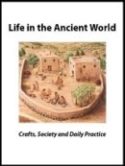
Dogs in the Bible were not well loved. To be called a dog was to be associated with evil and low status. Therefore it is surprising that Caleb, one of the great Hebrew spies, means “dog” in Hebrew. Pictured is a stone relief created in 1958 by sculptor Ferdinand Heseding. The relief, which appears on a fountain in Dusseldorf, Germany, depicts the Biblical spies Joshua and Caleb carrying a cluster of grapes back from the Promised Land (Numbers 13:1-33).
Everyone loves dogs—don’t they? Dogs—or celeb in Hebrew—are humanity’s best friends. We welcome them into our homes, we walk them, feed them, clean up after them and excuse their bad behavior. But in ancient Israel, people had an entirely different view of dogs.
Of the more than 400 breeds of dogs around today, all came from the same ancestor—ancient wolves. Dogs were first domesticated perhaps as far back as 12,000 years ago. Because dogs are the only animals with the ability to bark, they became useful for hunting and herding. Dogs in the Bible were used for these purposes (Isaiah 56:11; Job 30:1).
There is evidence in the Bible that physical violence toward dogs was considered acceptable (1 Samuel 17:43; Proverbs 26:17). To compare a human to a dog or to call them a dog was to imply that they were of very low status (2 Kings 8:13; Exodus 22:31; Deuteronomy 23:18; 2 Samuel 3:8; Proverbs 26:11; Ecclesiastes 9:4; 2 Samuel 9:8; 1 Samuel 24:14). In the New Testament, calling a human a dog meant that the person was considered evil (Philemon 3:2; Revelation 22:15).

Some scholars hypothesize that the negative feelings expressed in the ancient Near East toward dogs was because in those days, dogs often ran wild and usually in packs. Dogs in the Bible exhibited predatory behavior in their quest for survival, which included the eating of dead bodies (1 Kings 14:11; 16:4; 21:19, 23-24; 22:38; 2 Kings 9:10, 36; 1 Kings 21:23).
There is archaeological evidence, such as figurines, pictures and even collars, that demonstrates that Israel’s neighbors kept dogs as pets, but from the skeletal remains found within the Levant, the domestication of dogs did not happen until the Persian and Hellenistic periods within Israel.
The word for dog in Hebrew is celeb, from which the name Caleb derives. Due to the negative attribution of dogs for the ancient Israelites, it is surprising that one of the great Hebrew spies bears this name. As the Israelites were preparing to enter the land of Canaan, Moses called a chieftain from each tribe to go before them and scout the land. Caleb was the representative of the tribe of Judah. When these spies returned, they reported that the land surpassed expectation but that the people who live there would be mighty foes. The Israelites did not want to go and face the peoples of Canaan, but Caleb stepped forward and urged them to proceed. After more exhortation from Moses, Aaron and Joshua, the people relented. Caleb was rewarded for his faith: Joshua gave him Hebron as an inheritance (Numbers 14:24; Joshua 14:14).
 Ellen White, Ph.D. (Hebrew Bible, University of St. Michael’s College), was the senior editor at the Biblical Archaeology Society. She has taught at five universities across the U.S. and Canada and spent research leaves in Germany and Romania. She has also been actively involved in digs at various sites in Israel.
Ellen White, Ph.D. (Hebrew Bible, University of St. Michael’s College), was the senior editor at the Biblical Archaeology Society. She has taught at five universities across the U.S. and Canada and spent research leaves in Germany and Romania. She has also been actively involved in digs at various sites in Israel.
Further reading in the BAS Library:
John S. Crawford, “Caleb the Dog,” Bible Review, April 2004.
Lawrence E. Stager, “Why Were Hundreds of Dogs Buried at Ashkelon?” Biblical Archaeology Review, May/June 1991.
Not a BAS Library member yet? Join the BAS Library today.
Related reading in Bible History Daily:
What Does the Bible Say About Dogs?
Bible Animals: From Hyenas to Hippos
Canaan Canine Faces Threat in Israel
Millions of Mummified Dogs Uncovered at Saqqara
Camel Domestication History Challenges Biblical Narrative
This Bible History Daily feature was originally published on January 26, 2015.
Dig deeper into biblical Archaeology with your All-Access Membership
The world of the Bible is knowable. We can learn about the society where the ancient Israelites, and later Jesus and the Apostles, lived through the modern discoveries that provide us clues.
Biblical Archaeology Review is the guide on that fascinating journey. Here is your ticket to join us as we discover more and more about the biblical world and its people.
Each issue of Biblical Archaeology Review features lavishly illustrated and easy-to-understand articles such as:
• Fascinating finds from the Hebrew Bible and New Testament periods
• The latest scholarship by the world's greatest archaeologists and distinguished scholars
• Stunning color photographs, informative maps, and diagrams
• BAR's unique departments such as First Person and Strata
• Reviews of the latest books on biblical archaeology
The BAS Digital Library includes:
• 45+ years of Biblical Archaeology Review
• 20+ years of Bible Review online, providing critical interpretations of biblical texts
• 8 years of Archaeology Odyssey online, exploring the ancient roots of the Western world in a scholarly and entertaining way,
• The New Encyclopedia of Archaeological Excavations in the Holy Land
• Video lectures from world-renowned experts.
• Full online access to 50+ curated Special Collections,
• Four highly acclaimed books, published in conjunction with the Smithsonian Institution: Aspects of Monotheism, Feminist Approaches to the Bible, The Rise of Ancient Israel and The Search for Jesus.
The All-Access membership pass is the way to get to know the Bible through biblical archaeology.
The post No, No, Bad Dog: Dogs in the Bible appeared first on Biblical Archaeology Society.


0 Commentaires